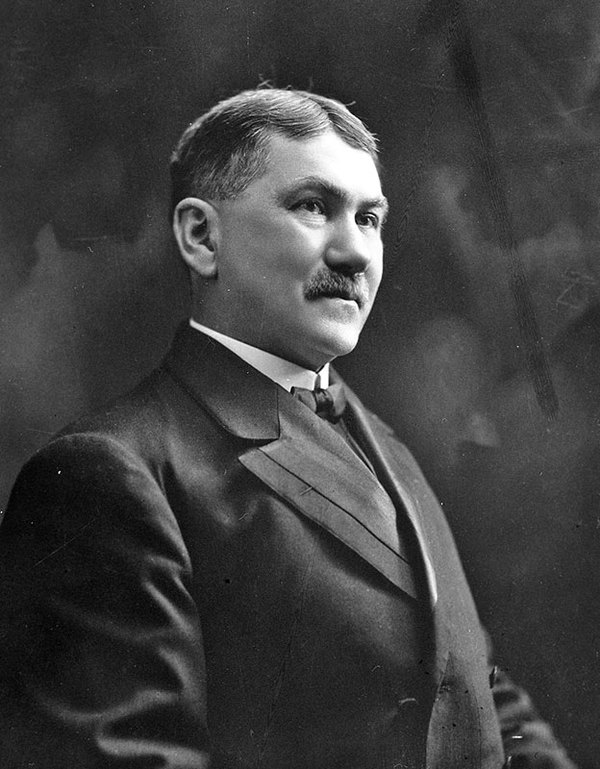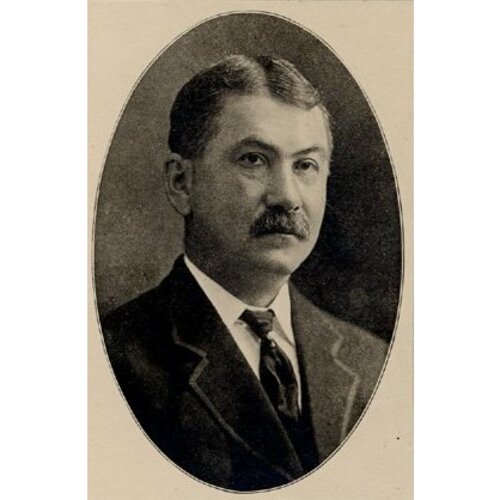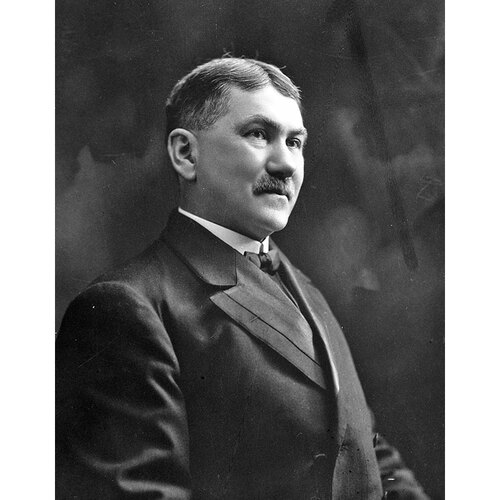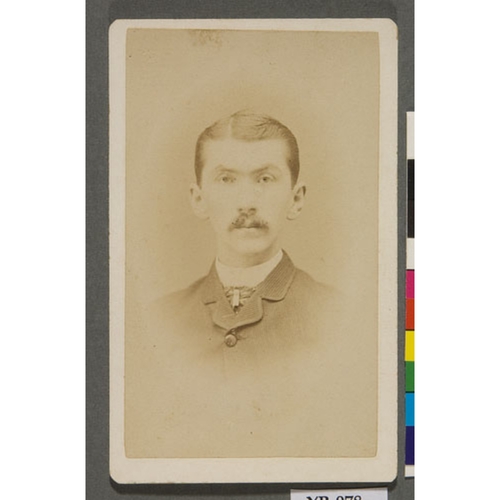
Source: Link
DROUIN, NAPOLÉON (baptized Olivier-Napoléon), shopkeeper, industrialist, and politician; b. 18 June 1862 in Quebec City, eldest son of Olivier Drouin, a carpenter, and Thérèse Canac, dit Marquis; m. there 5 July 1887 Almanda Lafond (d. 5 Jan. 1937), and they had 11 children, of whom 5 girls and 3 boys reached adulthood, and they adopted a boy; d. 26 June 1934 in Quebec City and was buried there three days later in Saint-Charles cemetery.
Shortly after their wedding in 1858 on the Île d’Orléans, Napoléon Drouin’s parents settled in Quebec City near the Marine and Emigrant Hospital in the Saint-Roch district. Olivier Drouin worked there as a carter. Around 1880 the couple opened a grocery store in the family home, where Napoléon and his two younger brothers, Alexis and Edmond, learned the basics of the retail trade. At a time of economic crisis, their father had a little capital that he used to buy a few plots of land from owners living in the United States, among others. In his will, probated in 1887, he left all his possessions to his wife and promised $100 to each of his children, to be given to them within two years of his death, which occurred in 1888.
The three brothers took over the business and on 21 Dec. 1888 formed the firm of Drouin Frères et Compagnie, with the aim of engaging in the wholesale- and retail-grocery trade. After their respective marriages Napoléon and Alexis established their places of residence near the family store on Rue Smith. Around 1896 the firm was set up as a wholesaler in a combined warehouse and store located between Rue Saint-André and Rue Saint-Paul, close to the port and at the end of Rue Saint-Pierre, an area considered to be the business centre of Quebec City. In 1896 the Drouin brothers acquired a property for $11,000, paying $2,000 cash, with the vendor financing the rest. They quickly added the manufacture of vinegar and spices to their commercial activities. In 1910 they partnered with Edward Ernest B. Rattray, a commission merchant dealing in flour and cereals, to form Drouin Frères et Rattray Limitée. The undertaking proved to be very risky because of Rattray’s financial difficulties. The net worth and the credit of the business temporarily declined. Eight years later the Drouin brothers managed to reverse the situation and pursue their activities, under the name Drouin Frères Limitée, until the mid 1930s.
Along with engaging in the grocery trade, which Napoléon had probably managed in the years since his father’s death, the brothers mobilized funds to purchase, personally or through their firm, several properties on Rue Smith, which enlarged the holdings inherited from their father. Thus, in January 1899 the eldest son was able to acquire for just $1,550 a huge plot of land owned by the shoe manufacturer William Alfred Marsh, on the site of the former Protestant cemetery of the Marine and Emigrant Hospital. It was here that in February 1899 Napoléon, his brothers, their cousin Alfred Drouin, and an associate, Joseph Picard, began to build a large tobacco factory at a cost of about $16,000. On 10 June they took the corporate name Rock City Tobacco Company. The principal shareholder, Napoléon, was its president, Alexis vice-president, and Picard general manager and secretary-treasurer.
The Rock City Tobacco Company managed, though not without difficulty, to carve a niche for itself in the competitive market of cut tobacco, pipe tobacco, and chewing tobacco in Quebec and the Maritimes. While several of its brands attempted to attract consumer loyalty (some, such as Rose Quesnel and Master Mason, would achieve this objective), most were short-lived, appealing to only a segment of the clientele because of their particular characteristics. Travelling salesmen and agents sought out retailers who agreed to become points of sale as part of an expanding Canadian distribution network. Marketing became more sophisticated, with the use of posters, advertisements in newspapers, displays, varied packaging, and a system of coupons that could be exchanged for gifts. The tobacco came from the United States and Canada. Several products used the supply from both these sources. The factory employed some 50 workers and was able to expand numerous times onto adjacent plots acquired by Drouin or by the company itself in response to the rapid growth of its activities. By 1907 its area had doubled, and in 1912‒13 a new wing allowed production to be increased by 50 per cent. From then on, there were about 250 factory workers, with an annual payroll of $90,000, and some 20 travelling salesmen. The Rock City Tobacco Company became one of the largest tobacco manufacturers in Canada.
The firm rapidly diversified its activities, first around 1901 with the construction of wooden boxes for its needs and those of other industries, and then with the sale of cigars made by J. A. Blais et Compagnie, an outfit in Lévis that Rock City took over in 1902 and ran from 1903 under the name Rock City Cigar Company. It also started to make cigarettes on a small scale around the beginning of the 1910s, before launching the Bluebird brand after World War I and, notably, in the mid 1920s, the menthol Spud, which was produced in its plant under an American licence. Share transfers at the time of corporate restructuring indicate that in 1920 the Rock City Tobacco Company, including its assets, land, factory and other buildings, merchandise, credit and debts, goodwill, and trademarks, would have been worth about $2.5 million. In 1925, using its properties as collateral, it even issued $800,000 worth of bonds at 6 per cent to finance its growth.
Drouin, his family, and his partners became involved in several economic sectors, mainly the production of candy, chocolate, and syrups under the name Bonbons Candiac (Canada) Limited from 1920; the making of biscuits, confectionery, breads, cakes, and pastries under the registered trade name Biscuits Charest (in facilities acquired early in 1929 from Wilfrid Charest); and logging through the D’Auteuil Lumber Company Limited. Drouin also sat on several boards of directors, among them that of the Deschambault Quarry Corporation.
Like many Quebec City industrialists, Drouin was heavily engaged in the development of commercial land in the Saint-Roch and Saint-Pierre districts: at times he borrowed sums close to $60,000 from local financial institutions, such as the Société de Prêts et de Placements de Québec and the Prévoyants du Canada. At the beginning of the 1910s he invested in subdivision projects of the Compagnie du Parc Maufils and Parc Richelieu Limité in the Limoilou district and in Charlesbourg (Quebec). In 1922 he had the means to take part in the rescue of the Banque Nationale, organized by businessman Georges-Élie Amyot*; as proof of his social commitment, he undertook to purchase $100,000 worth of shares in the financial institution.
Firmly established in the Saint-Roch district through his industrial and commercial activities, Drouin lived on Rue Smith until 1904. He then moved close to the convent and church of Saint-Roch on Rue Saint-François, where his brother Alexis and his associate Picard soon joined him as neighbours. He would remain there until his death. It is not surprising that he represented the people of the district as municipal councillor from 1896 to 1909. Defeating Senator Philippe-Auguste Choquette*, Drouin became mayor of Quebec City in 1910, a post to which he would be re-elected by acclamation in the two contests that followed. He retired from politics in 1916.
Drouin’s terms in office were notably characterized by the annexation of Limoilou in 1909, the absorption of Ville-Montcalm in 1913, and the integration of a few sections of the territory of La Petite-Rivière (used for the railway-equipment repair and maintenance facility of the Saint-Malo district) and land close to the Hôpital Saint-Michel-Archange in 1914 (for the construction of the Hôpital Civique). Drouin was especially preoccupied with developing these new suburbs. At the end of six years of administration he could boast of having invested in infrastructure in particular: paving and widening streets and gradients, erecting several bridges (one of which still bears his name in the early 21st century), and installing a 40-inch water main (1912–13). He also introduced competitive bidding for the city’s electricity-supply contract (1912), chose the Bank of Montreal as the underwriting syndicate (1911), and placed the Quebec provincial exposition under municipal control so that it could be held annually (1912). Also, for the entire period of his terms of office as mayor, he carried out complex and difficult negotiations with the federal government concerning the sale of the Champlain market, the creation of the Union (Palace) station, and the National Transcontinental Railway factories in the Saint-Malo district. As well, he rebuilt the Dufferin Terrace, which had been destroyed by fire in 1914.
Thereafter, Drouin continued to manage his businesses with his brothers and Picard. He integrated his sons into the Rock City Tobacco Company, as Picard did with his, Édouard and Augustin-Clovis. Olivier-Napoléon, Napoléon’s eldest son, as well as his brothers Gustave and Charles-Auguste, served in various capacities and prepared to take over from their father. The death of Picard in 1932 and that of Drouin in 1934, after a long and painful illness, left the presidency open for Olivier-Napoléon, the vice-presidency for Augustin-Clovis, and the post of secretary-treasurer for Édouard. In a period of economic depression and falling prices, the market for tobacco products and cigarettes was substantially transformed. The intense competition between the Imperial Tobacco Company of Canada Limited and other independent businesses grew so fierce that it prompted the creation of the royal commission on price spreads (1934–35). In 1936 shares in the Rock City Tobacco Company were worth barely $500,000. It was in this context that control of the company passed that year into the hands of Carreras Limited of London. The only firm capable of competing with Imperial Tobacco, Carreras arrived in Quebec City with its efficient cigarette-production machines and already well-established brands, such as Craven “A” and Black Cat. It left local management in place. The legacy of Napoléon Drouin thus endured.
The Great Depression appears to have had an impact on Drouin’s other businesses too: Drouin Frères Limitée experienced difficulties and disappeared a short time after his death. In 1932 he himself had been compelled to borrow $10,000 at 6 per cent by mortgaging the family home on Rue Saint-François. At the time he was struck by the illness from which he would die, he owned a number of other properties, including a beautiful country house in Château-Richer, named the Terre du Chateau Beaupré, acquired in 1913 for $7,000. His widow renounced her claim to the joint estate and was content with life-insurance policies, while the children received their share in the will, probated in 1933, which specified the terms of access to the country house and its outbuildings. It is far from certain that the other properties were worth much given the prevailing economic conditions. The Sisters of Charity of Quebec rented the family home in 1934 for the charitable organization Notre-Dame-du-Bon-Conseil and purchased it in 1936, after the estate had been settled.
In June 1934, when the newspapers of Quebec City took stock of Napoléon Drouin’s career, they emphasized the diversity of his qualities as a business and industrial entrepreneur, which were acknowledged in particular by his participation in the Quebec Liquor Commission (from its creation in 1921) and on the boards of directors of financial institutions. They also noted his successes in municipal politics. In its edition of 26 June, Le Soleil quoted the remarks of one of his long-time collaborators, who described him as “‘a glutton for work’ who paid no heed to the hours or the time to get to work and who always found something to undertake.”
BANQ-Q, CE301-S11, 9 févr. 1858; CE301-S22, 19 juin 1862; CE301-S93, 5 juill. 1887; CN301-S128, 25 janv. 1887; CN301-S304, 29 sept. 1896; CN301-S369, 20 janv. 1899; CN301-S374, 17 mars 1913; CN301-S460, 3 févr. 1920, 17 sept. 1925; TP11, S1, SS20, SSS48, 21 déc. 1888. FD, Cimetière Saint-Charles (Québec), 29 juin 1934, 8 janv. 1937. Québec, Ministère de l’Énergie et des Ressources Naturelles, “Reg. foncier du Québec en ligne,” acte, radiation, avis d’adresse, Québec, acte, nos.43354rb, 59321rb, 61841rb, 215554rb, 230186rb, 239944rb, 244824rb, 244825rb, 245280rb, 247743rb: www.registrefoncier.gouv.qc.ca/Sirf (consulted 18 Feb. 2016). L’Action catholique (Québec), 26, 28, 29, 30 juin 1934; 24 juill. 1959. Le Devoir, 26 juin 1934. Le Soleil, 26, 29, 30 juin 1934. L’Administration Drouin aux contribuables ([Québec?, 1914?]). BCF, 1920: 77. Nathalie Bouchard and Réjean Lemoine, The Rothmans, Benson & Hedges factory: in the heart of Quebec City for the past 100 years: 1899–1999 ([Quebec, 1999?]). Bradstreet’s book of commercial ratings of bankers, merchants, manufacturers, etc., in the United States and Canada (New York), 1912–17. The Canadian trade review: an illustrated descriptive edition of the city of Quebec and district, treating of their history, resources, industries, scenery and waterfalls ([Montreal?, 1908?]), 84, 93. F.‑X. Chouinard et al., La ville de Québec, histoire municipale (4v., Québec, 1963–83), 4. L.‑M. Côté et al., Les maires de la vieille capitale (Québec, 1980). Directory, Quebec, 1860–1934. The mercantile agency reference book … (Montreal), 1912–17. Publicity Bureau, City of Quebec, Quebec, Canada ([Quebec?, 1913?]). Quebec Official Gazette, 1910: 119–20. Six années d’administration: son honneur Napoléon Drouin, maire de Québec, 1er mars 1910–1er mars 1916 (Québec, 1916).
Cite This Article
Marc Vallières, “DROUIN, NAPOLÉON (baptized Olivier-Napoléon),” in Dictionary of Canadian Biography, vol. 16, University of Toronto/Université Laval, 2003–, accessed December 23, 2025, https://www.biographi.ca/en/bio/drouin_napoleon_16E.html.
The citation above shows the format for footnotes and endnotes according to the Chicago manual of style (16th edition). Information to be used in other citation formats:
| Permalink: | https://www.biographi.ca/en/bio/drouin_napoleon_16E.html |
| Author of Article: | Marc Vallières |
| Title of Article: | DROUIN, NAPOLÉON (baptized Olivier-Napoléon) |
| Publication Name: | Dictionary of Canadian Biography, vol. 16 |
| Publisher: | University of Toronto/Université Laval |
| Year of publication: | 2020 |
| Year of revision: | 2020 |
| Access Date: | December 23, 2025 |





